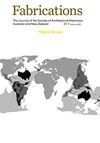The Architecture of the State and Statelessness
IF 0.3
0 ARCHITECTURE
Fabrications-The Journal of the Society of Architectural Historians Australia and New Zealand
Pub Date : 2022-09-02
DOI:10.1080/10331867.2023.2202529
引用次数: 0
Abstract
The phrases “state architecture” and “architecture of the state” today might be understood to refer not to buildings at all, but to the formal arrangements of power in sovereign states; the composition of a representative assembly, for example, and the relationship between the judiciary and the executive; the role of the bureaucracy and ministers of state and other such arrangements that define who can legitimately exercise state power. Such a usage implies that the word architecture principally denotes a diagram of functions and responsibilities. This editors’ themed issue of Fabrications is dedicated to a more expansive, but also more concrete and conventional idea of “the architecture of the state.” For the work included here, architecture unquestionably involves the design and use of buildings. Yet, each of the papers in the current issue also coveys a sense that architecture is inexorably involved in delineating relations of power. One of the abiding roles of architecture historically has been to produce designs for buildings that represent and house state functions. Official residences for heads of state, parliament buildings, courts, diplomatic missions, barracks and armouries, as well as the departmental headquarters for treasuries and other governmental functions, enact and enable state power, but they also make the state visible as an entity. Architecture is one of the ways in which states represent themselves to their citizens or political subjects and to other states. The frontispiece for the original edition of Thomas Hobbes’ Leviathan (1651) – perhaps the most explicit figure of the state produced in political philosophy – is an etching by Thomas Bosse and is dominated by a colossal figure bearing a sword and a mitre overlooking an orderly city (Fig. 1). When one looks closely at the cover, the representative role of architecture in figuring state power is obvious. Beneath the main figure are depictions of civil and ecclesiastical authority, most prominently a castle and a church. Buildings were thus presented as clear emblems of the state. Perhaps because state power is so often figured through buildings and urban ensembles, those who dispute the claims of the state have also used architecture to articulate their own relationship to power and political agency. In Australia, for example, First Nations people have created numerous tent embassies, the most famous being that established in front of the old Parliament House in Canberra from 1972. The very clear meaning of this gesture was that the Australian government does not possess legitimate FABRICATIONS 2022, VOL. 32, NO. 3, 335–339 https://doi.org/10.1080/10331867.2023.2202529国家的架构和无状态
今天的“国家建筑”和“国家的建筑”这两个短语可能被理解为根本不是指建筑,而是指主权国家的正式权力安排;例如,代表大会的组成,以及司法部门和行政部门之间的关系;官僚机构和国务部长的作用,以及其他定义谁可以合法行使国家权力的安排。这样的用法意味着架构一词主要表示功能和职责的图表。本期编辑主题为《建筑》的杂志致力于“国家的建筑”这一更广阔、更具体、更传统的概念。对于本文所包含的作品来说,建筑无疑涉及建筑的设计和使用。然而,本期的每一篇论文都有一种感觉,即建筑不可避免地参与了权力关系的描绘。历史上,建筑的一个永恒角色是为代表和容纳国家功能的建筑设计。国家元首的官邸、议会大厦、法院、外交使团、营房和军械库,以及财政部和其他政府职能部门的部门总部,制定并启用了国家权力,但它们也使国家成为一个实体。建筑是国家向其公民或政治主体以及其他国家表达自己的方式之一。托马斯·霍布斯(Thomas Hobbes)的《利维坦》(Leviathan,1651)原版的正面作品——也许是政治哲学中最明确的国家形象——是托马斯·博塞(Thomas Bosse)的蚀刻作品,由一个手持剑和王冠的巨大人物主导,俯瞰着一座有序的城市(图1)。仔细看封面,建筑在塑造国家权力方面的代表性作用是显而易见的。主要人物下面是对公民和教会权威的描绘,最突出的是一座城堡和一座教堂。因此,建筑物被视为国家的明确象征。也许是因为国家权力经常通过建筑和城市综合体来体现,那些对国家主张提出异议的人也用建筑来表达他们自己与权力和政治机构的关系。例如,在澳大利亚,原住民创建了许多帐篷大使馆,最著名的是1972年在堪培拉旧议会大厦前建立的大使馆。这一姿态的明确含义是,澳大利亚政府不拥有合法的《2022年纺织品》,第32卷,第335-339号https://doi.org/10.1080/10331867.2023.2202529
本文章由计算机程序翻译,如有差异,请以英文原文为准。
求助全文
约1分钟内获得全文
求助全文
来源期刊

CiteScore
0.50
自引率
25.00%
发文量
26
 求助内容:
求助内容: 应助结果提醒方式:
应助结果提醒方式:


